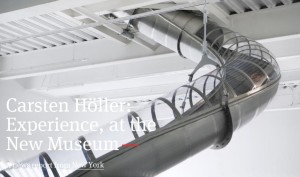True to the title of the exhibition, Höller’s work explores the limits of sensorial perception and logic through participatory experiences
 The New Museum presents the first New York survey exhibition of the work of the German artist Carsten Höller (b. 1961, Brussels, lives and works in Stockholm). Over the past twenty years, Höller has created a world that is equal parts laboratory and test site, exploring such themes as childhood, safety, love, the future, and doubt. Höller left his early career as a scientist in 1993 to devote himself exclusively to art making, and his work is often reminiscent of research experiments. His pieces are designed to explore the limits of human sensorial perception and logic through carefully controlled participatory experiences.
The New Museum presents the first New York survey exhibition of the work of the German artist Carsten Höller (b. 1961, Brussels, lives and works in Stockholm). Over the past twenty years, Höller has created a world that is equal parts laboratory and test site, exploring such themes as childhood, safety, love, the future, and doubt. Höller left his early career as a scientist in 1993 to devote himself exclusively to art making, and his work is often reminiscent of research experiments. His pieces are designed to explore the limits of human sensorial perception and logic through carefully controlled participatory experiences.
The selected works emphasize the experimental quality of Höller’s work and reveal the complex universe of one of the most significant European artists to emerge in the past twenty years. Höller came to prominence alongside a group of artists in the 1990s including Maurizio Cattelan, Dominique Gonzalez-Foerster, Pierre Huyghe, Philippe Parreno, and Rirkrit Tiravanija who worked across disciplines to re-imagine the experience and the space of art. Höller stands out among this group for the manner in which his installations drew on the history and method of scientific experimentation to destabilize the viewer’s perception of space, time, and the concept of self. In providing this first opportunity for the public here to examine the full scope of Höller’s artistic experiments, the exhibition follows in the New Museum’s long tradition of introducing the most adventurous international artists to an American audience.
At the New Museum, viewers will be encouraged to test a variety of sculptural experiences. In Höller’s Psycho Tank (1999), visitors will float weightlessly in a sensory deprivation pool, providing a strange out-of-body experience. In these scenarios, as in his other work, Höller treats the viewer as the subject and audience for his radical and disorienting experiments.(c) Domus
New Museum, 235 Bowery, New York NY 10002


